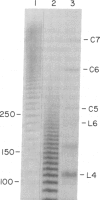Abstract
We used gel electrophoresis methods to show that reaction of DNA with cis-diamminedichloroplatinum(II) results in a substantial (approximately equal to 40 degrees) bend in the double helix at the intrastrand crosslink between the N7 atoms of adjacent guanosine nucleosides, which bond to the platinum(II) complex with loss of two chloride ions. Multimers of a 22-base-pair (bp) oligonucleotide platinated at a single site show strong anomalies in their electrophoretic mobilities as a consequence of coherent addition of in-phase platinum-induced bends. Increase of the sequence repeat of the platinated site to 27 bp yields multimers of nearly normal mobility because the bends are out of phase. The direction of Pt-induced bends relative to adenosine-tract bends was determined from the electrophoretic mobility of multimers in which repeated platination sites are interdigitated at various phasings relative to repeated adenosine tracts. Optimum bending occurs when 1.5 helical turns separate the cis-[Pt(NH3)2[d(pGpG)]](N7,N7) adducts from the center of the adenosine tracts. This phasing produces coherent addition of adenosine tract bends toward the minor groove at their centers and Pt-induced bends toward the major groove, where the platinum is located.
Full text
PDF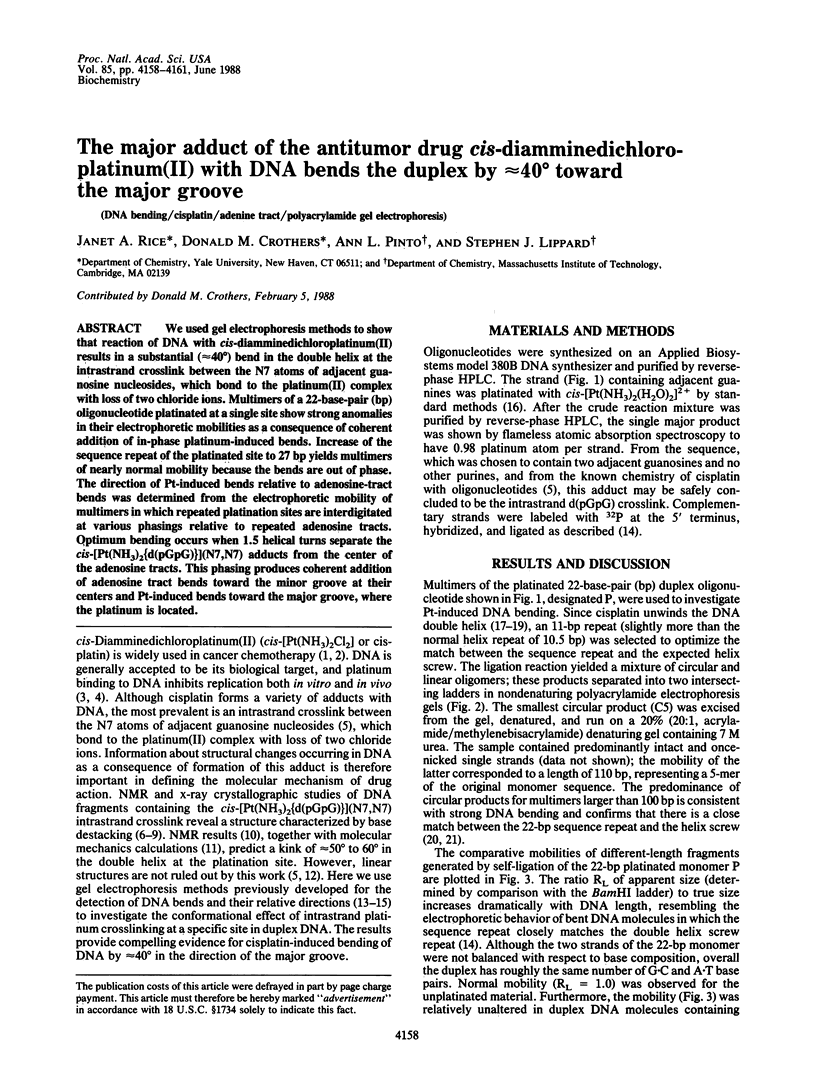
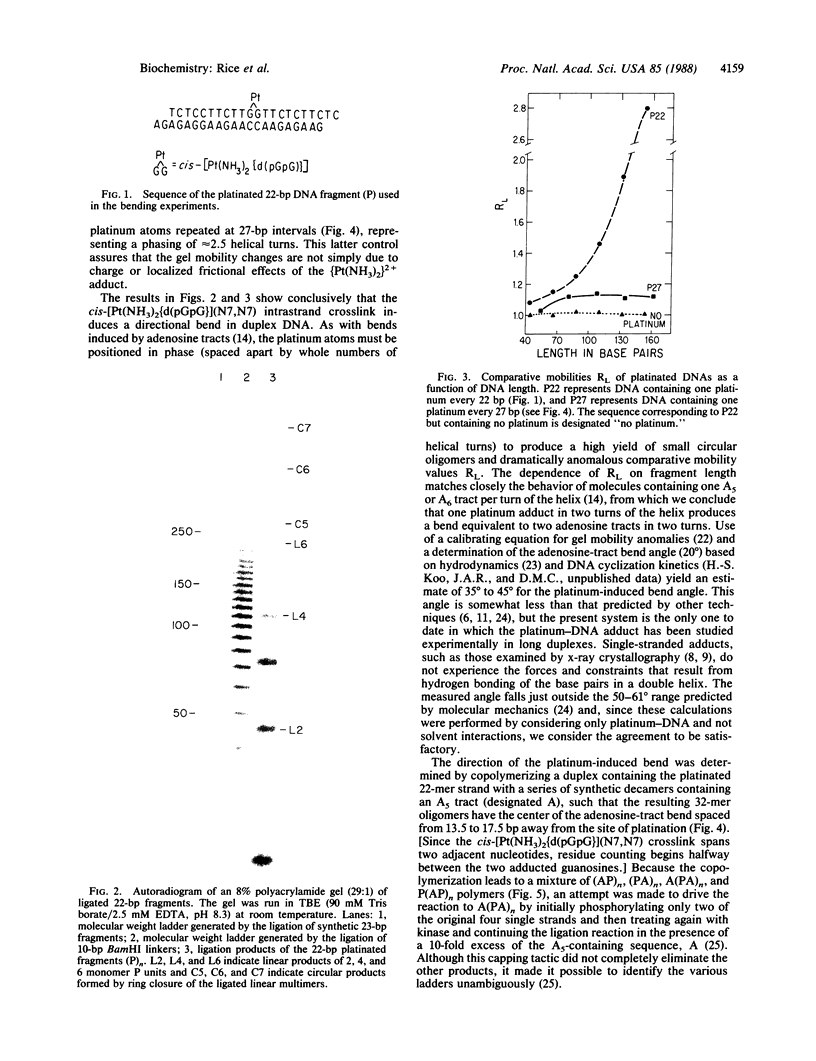
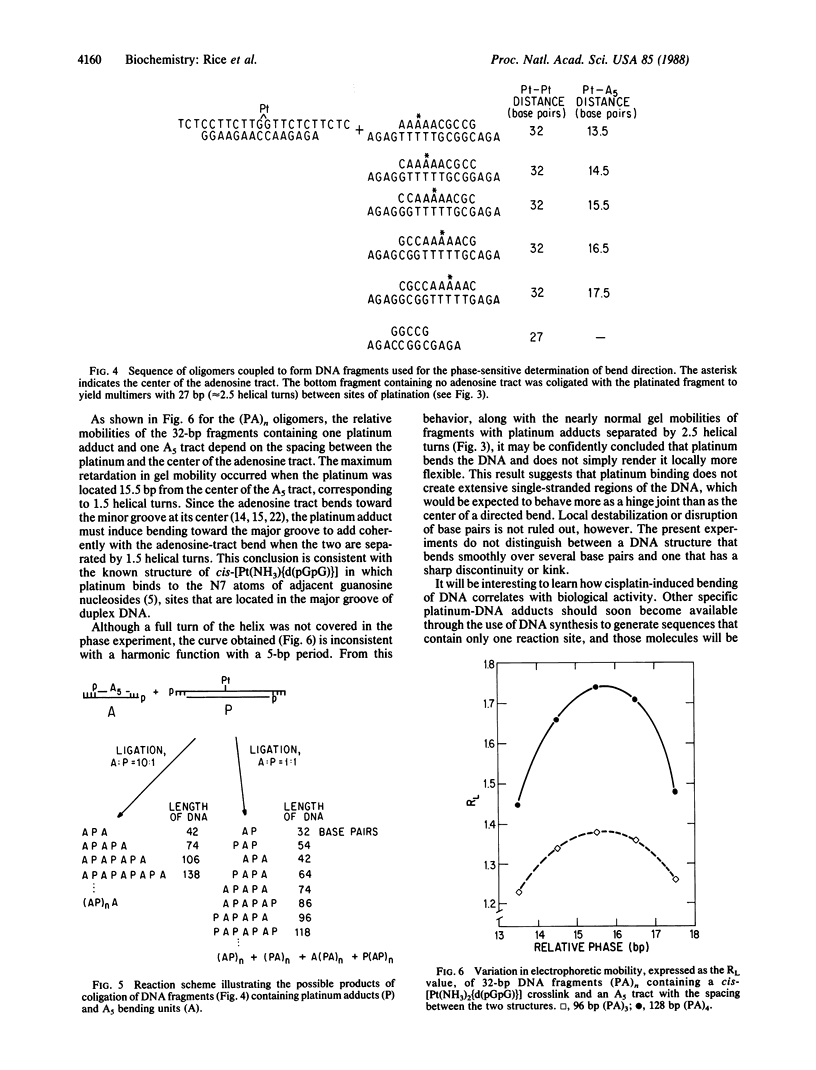
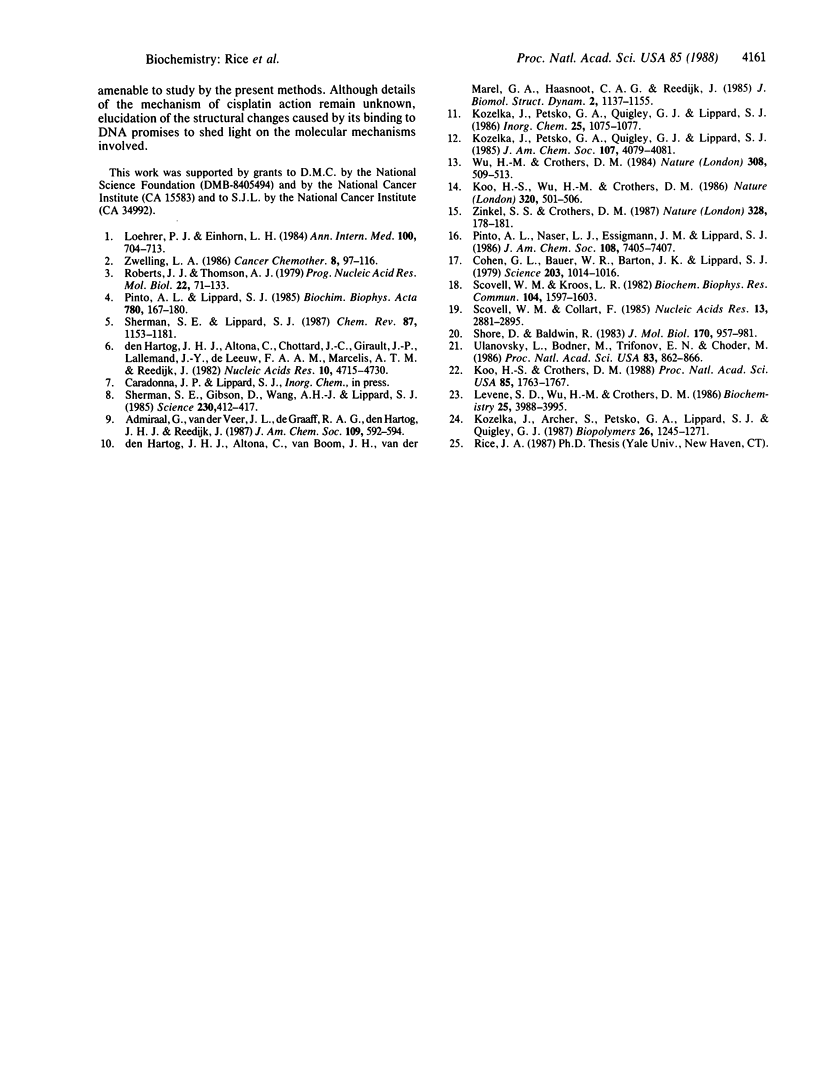
Images in this article
Selected References
These references are in PubMed. This may not be the complete list of references from this article.
- Cohen G. L., Bauer W. R., Barton J. K., Lippard S. J. Binding of cis- and trans-dichlorodiammineplatinum(II) to DNA: evidence for unwinding and shortening of the double helix. Science. 1979 Mar 9;203(4384):1014–1016. doi: 10.1126/science.370979. [DOI] [PubMed] [Google Scholar]
- Koo H. S., Crothers D. M. Calibration of DNA curvature and a unified description of sequence-directed bending. Proc Natl Acad Sci U S A. 1988 Mar;85(6):1763–1767. doi: 10.1073/pnas.85.6.1763. [DOI] [PMC free article] [PubMed] [Google Scholar]
- Koo H. S., Wu H. M., Crothers D. M. DNA bending at adenine . thymine tracts. Nature. 1986 Apr 10;320(6062):501–506. doi: 10.1038/320501a0. [DOI] [PubMed] [Google Scholar]
- Kozelka J., Archer S., Petsko G. A., Lippard S. J., Quigley G. J. Molecular mechanics modeling of oligonucleotide adducts of the antitumor drug cis-diamminedichloroplatinum(II). Biopolymers. 1987 Aug;26(8):1245–1271. doi: 10.1002/bip.360260804. [DOI] [PubMed] [Google Scholar]
- Levene S. D., Wu H. M., Crothers D. M. Bending and flexibility of kinetoplast DNA. Biochemistry. 1986 Jul 15;25(14):3988–3995. doi: 10.1021/bi00362a003. [DOI] [PubMed] [Google Scholar]
- Loehrer P. J., Einhorn L. H. Drugs five years later. Cisplatin. Ann Intern Med. 1984 May;100(5):704–713. doi: 10.7326/0003-4819-100-5-704. [DOI] [PubMed] [Google Scholar]
- Pinto A. L., Lippard S. J. Binding of the antitumor drug cis-diamminedichloroplatinum(II) (cisplatin) to DNA. Biochim Biophys Acta. 1985;780(3):167–180. doi: 10.1016/0304-419x(85)90001-0. [DOI] [PubMed] [Google Scholar]
- Roberts J. J., Thomson A. J. The mechanism of action of antitumor platinum compounds. Prog Nucleic Acid Res Mol Biol. 1979;22:71–133. doi: 10.1016/s0079-6603(08)60799-0. [DOI] [PubMed] [Google Scholar]
- Scovell W. M., Collart F. Unwinding of supercoiled DNA by cis- and trans-diamminedichloroplatinum(II): influence of the torsional strain on DNA unwinding. Nucleic Acids Res. 1985 Apr 25;13(8):2881–2895. doi: 10.1093/nar/13.8.2881. [DOI] [PMC free article] [PubMed] [Google Scholar]
- Scovell W. M., Kroos L. R. Cis- and trans-diamminedichloroplatinum(II) binding products different tertiary structural changes on SV40 DNA. Biochem Biophys Res Commun. 1982 Feb 26;104(4):1597–1603. doi: 10.1016/0006-291x(82)91435-8. [DOI] [PubMed] [Google Scholar]
- Sherman S. E., Gibson D., Wang A. H., Lippard S. J. X-ray structure of the major adduct of the anticancer drug cisplatin with DNA: cis-[Pt(NH3)2(d(pGpG))]. Science. 1985 Oct 25;230(4724):412–417. doi: 10.1126/science.4048939. [DOI] [PubMed] [Google Scholar]
- Shore D., Baldwin R. L. Energetics of DNA twisting. I. Relation between twist and cyclization probability. J Mol Biol. 1983 Nov 15;170(4):957–981. doi: 10.1016/s0022-2836(83)80198-3. [DOI] [PubMed] [Google Scholar]
- Ulanovsky L., Bodner M., Trifonov E. N., Choder M. Curved DNA: design, synthesis, and circularization. Proc Natl Acad Sci U S A. 1986 Feb;83(4):862–866. doi: 10.1073/pnas.83.4.862. [DOI] [PMC free article] [PubMed] [Google Scholar]
- Wu H. M., Crothers D. M. The locus of sequence-directed and protein-induced DNA bending. Nature. 1984 Apr 5;308(5959):509–513. doi: 10.1038/308509a0. [DOI] [PubMed] [Google Scholar]
- Zinkel S. S., Crothers D. M. DNA bend direction by phase sensitive detection. Nature. 1987 Jul 9;328(6126):178–181. doi: 10.1038/328178a0. [DOI] [PubMed] [Google Scholar]
- den Hartog J. H., Altona C., Chottard J. C., Girault J. P., Lallemand J. Y., de Leeuw F. A., Marcelis A. T., Reedijk J. Conformational analysis of the adduct cis-[Pt(NH3)2 d(GpG)]+ in aqueous solution. A high field (500-300 MHz) nuclear magnetic resonance investigation. Nucleic Acids Res. 1982 Aug 11;10(15):4715–4730. doi: 10.1093/nar/10.15.4715. [DOI] [PMC free article] [PubMed] [Google Scholar]
- den Hartog J. H., Altona C., van Boom J. H., van der Marel G. A., Haasnoot C. A., Reedijk J. cis-diamminedichloroplatinum(II) induced distortion of a single and double stranded deoxydecanucleosidenonaphosphate studied by nuclear magnetic resonance. J Biomol Struct Dyn. 1985 Jun;2(6):1137–1155. doi: 10.1080/07391102.1985.10507629. [DOI] [PubMed] [Google Scholar]



